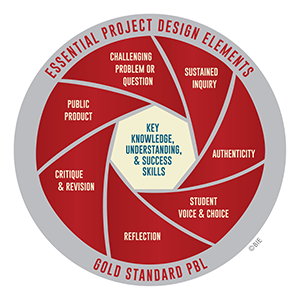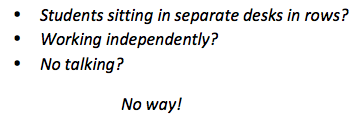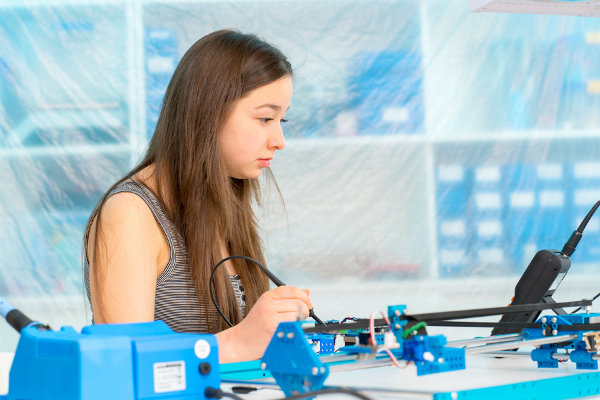Needed: 4 Radical Shifts in How We Teach Kids
A MiddleWeb Blog

That’s good news, but we face some big challenges to get STEM education where it can fully deliver on its potential.
The national nonprofit 100Kin10 has mapped out over 100 grand challenges for STEM education. I’ve compiled a more modest list of four areas where I think we could focus to radically improve STEM – and other subjects as well.
These will look familiar, and some schools already provide examples of excellence in these areas. But for the most part, most schools are still at the starting gate.
So, let’s do something radical! Let’s aim for some extreme changes in these four areas in 2019.
Extreme Change 1: A radical K-12 curriculum shift – include engineering in every subject

Strange, since these skills are increasingly necessary for students to flourish in what will soon be the third decade of the 21st century. Other than in STEM classes, where will they learn and practice soft skills like teamwork, effective communication, and creative problem solving?
How about this idea? Incorporate engineering into all subjects. Kids need to encounter STEM thinking and skills in all subjects, and engineering is an effective integration approach for doing this. Engineering promotes curiosity, creativity, communication, collaboration, persistence, and ethics, among other things. It teaches kids to balance constraints and criteria, focus on solutions for problems, and learn from failure.
In other words, engineering promotes the kind of critical thinking and creative problem-solving that helps kids deal successfully with change throughout their lives. Start by including the engineering design process across the curriculum in 2019.
Extreme Change 2: A radical pedagogical shift by all teachers – teach ‘STEM style’ in all classrooms
We know from research that students are social learners – they learn best with and from each other. And they remember best when what they learn is placed in real world contexts. (Imagine a school where paper-and-pencil, sit-and-get is banned for 2019!)

Source: The Buck Institute
A widely used teaching method for this type of learning is Project-based learning (PBL). PBL is already par for the course in STEM education where students tackle authentic problems and work together for an extended time on solutions.
STEM has been around long enough for educators to see its outcomes and practices unfold in schools across the nation. In her LittleBits Blog post Allison VanNest asserts that STEM-related learning is becoming a part of every subject.
She notes that in 2019 “educators will increasingly incorporate STEM lessons into English, history, social studies, art, and every subject in between.” Using a PBL approach, teachers can do this in a way that encourages students to be entrepreneurs – to explore and invent.
Extreme Shift 3: Knowledgeable, empowered teachers – well-compensated and dedicated to cutting-edge STEM learning

Professional learning for teachers will also involve teachers in meeting regularly during the school day to focus on best practices for teaching STEM and deliver 21st century learning to students. (Find ideas for teacher teaming by typing “team to teach” in a search engine.)
In 2019, all teachers need regular guidance and instruction on digital literacy. They must be able to help kids master essential skills and help students develop healthy habits and attitudes when using technology.
Teacher professional learning and support is integral to teaching STEM. In 2019 we should signal that by offering teachers compensation for workshops they attend and by providing time for them to work together during the school day to continue their learning.
Source: Digital Promise
Here’s another winning idea: Consider awarding Micro-credentials (see here also) for encouraging and rewarding specific teacher competencies.
Extreme Shift 4: A transformed K-12 learning space for all STEM classrooms – from institutional to comfortable

21st century classrooms must be flexible, inclusive spaces that allow for a variety of grouping arrangements. Kids can move around to areas such as workstations, standing tables, round tables, and makerspaces (collaborative workspaces) to name a few. STEM Kids need a room layout that helps them communicate, collaborate, create, experiment, analyze, and learn leadership skills.
A main feature of a contemporary STEM classroom is true technology integration. According to Beverly Woolf, AI (artificial Intelligence) will be a game changer in classrooms and will personalize learning and mentor students.
Believe it or not, lighting is an important part of up-to-date classroom design. Lighting affects kids’ levels of alertness and productivity, as well as their emotions. Provide natural lighting to students to make them more comfortable, reduce headaches, and improve learning.
If your school is not ready to make wholesale classroom changes, do something radical and begin making changes yourself – possibly with the help of interested parents. Check out this classroom architect website tool to play with different arrangements. Also take a look at this article – at the bottom are tips for making simple but perhaps profound changes in your classroom on a teacher’s budget.
Bid Groundhog Day Good-bye
So there you have it – four grand STEM challenges for 2019 – which were also the grand challenges for 2018, 2017, and previous years. Let’s stop reliving the same year over and over. Let’s do something radical. Let’s change this outdated system from the classroom up!

































Dear Anne, I am a retired teacher. I left the high school classroom in 2010 but I am a student teacher supervisor with the University of Michigan-Dearborn. I taught Spanish for 37 years and now supervise student teachers of World Languages. My husband, also retired, taught art to all grades for 39 years.
I have a real problem with the acronym STEM. I think it should be STEAM–add the arts in there! We can produce all the little robots we want, but what is this world without the beauty of painting, sculpture and all the visual arts? Is there any part of this world without music? What would you do if you couldn’t communicate with someone from another culture? How will students learn about home management and financial planning? What will happen to all of our students if they stayed on their computers and phones all day and didn’t get up and move? This would be a terrible world!
Thank you for listening to my rant. Off the soap box.
Hi Emily!
As a current professor of education, I fully support your recommendation to add the “A” in STEM. Absolutely, the arts are critical to the development of our minds and can connect learning in ways words do not.
Unfortunately, I don’t think you are hearing the message Anne is trying to convey. Ironically, sharing that we can “build all the little robots” is discrediting the added benefit of engineering, much like you feel discredited from the arts being omitted in STEM.
A huge chunk of Anne’s article is describing the significance of students moving and I didn’t notice anything about staying on computers and phones all day in the article… did I miss it?
Let’s hope 2019 can also be the year we listen. The year where we hear the views of others without advocating for our preferences. The year where we stop listening/reading just to state a rebuttal and truly consider the issue someone else is passionate about.
To answer one of your questions about music, no, any part of this world without music is not a world in which I want to live. I respect your message, your dedication to the profession, and your commitment to supervising student teachers. I hope you see my response as one full of support for STEAM as well as “all the little robots.”
Take care,
Elizabeth
Hi, Emily – I agree with you about the value of art and other subjects. And like you – I can’t imagine a world without art. One of my sons is a classical pianist and he adds so much beauty to world. I can’t envision STEM or any subject without art. Think of the visuals – PowerPoint to videos – that teachers use to teach. Kids in are sketching, using graphics, and designing artistic presentations. In fact, art is at the heart of communication in STEM.
I guess the reason I don’t refer to STEM as STEAM is because the whole point of STEM is to ratchet up the rigor in math and science (through engineering) by integrating the two in tandem with technology. I don’t think the role of art is to improve rigor in math and science. In other words, the point of art is not to solve a problem involving (eg.) water pollution.That’s an engineering problem.
Here’s what my artist son wrote when I asked him if he though art should be a part of STEM. “Art draws us together with a power and beauty that lifts our spirits, elevates our thinking, and enriches our experiences. It’s the best part of what makes us human. Engineering and technology can certainly serve the artist and evolve the art. But if we’re talking about viewing art in our schools simply as a way to serve engineering, it seems we’re missing the point and devaluing or not realizing art’s purpose and importance. It seems we have it backwards.”
STEM doesn’t mean that kids shouldn’t master language arts, history and social studies, and all forms of visual and performing art. They should. It simply means that the study of math and science needs to be done in a different manner than we’ve used previously – by integrating those two subjects through engineering.
So, from my standpoint, I guess here’s my advice: Implement a program that will help kids develop a more in-depth mastery of science, math, and technology through an engineering design process. Use a PBL approach that involves both the arts and humanities in designing solutions for real world problems. Be sure it focuses on creativity, innovation, inventing, critical thinking, and collaboration. And call it what you will. Fair enough?
Thanks for your comment! It made me think.